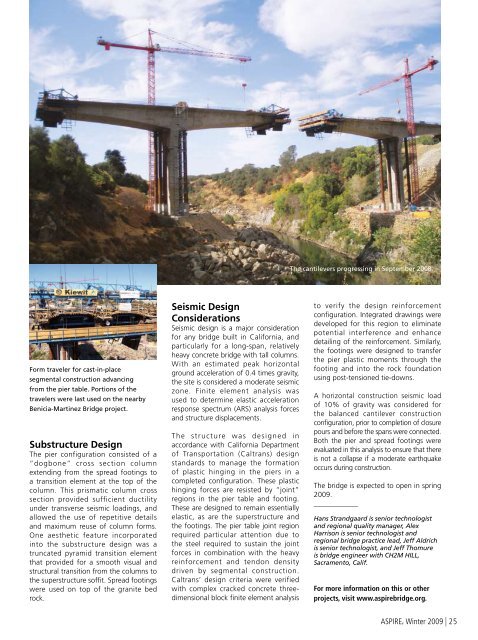Folsom Lake Crossing - Aspire - The Concrete Bridge Magazine
Folsom Lake Crossing - Aspire - The Concrete Bridge Magazine
Folsom Lake Crossing - Aspire - The Concrete Bridge Magazine
Create successful ePaper yourself
Turn your PDF publications into a flip-book with our unique Google optimized e-Paper software.
<strong>The</strong> cantilevers progressing in September 2008.<br />
Form traveler for cast-in-place<br />
segmental construction advancing<br />
from the pier table. Portions of the<br />
travelers were last used on the nearby<br />
Benicia-Martinez <strong>Bridge</strong> project.<br />
Substructure Design<br />
<strong>The</strong> pier configuration consisted of a<br />
“dogbone” cross section column<br />
extending from the spread footings to<br />
a transition element at the top of the<br />
column. This prismatic column cross<br />
section provided sufficient ductility<br />
under transverse seismic loadings, and<br />
allowed the use of repetitive details<br />
and maximum reuse of column forms.<br />
One aesthetic feature incorporated<br />
into the substructure design was a<br />
truncated pyramid transition element<br />
that provided for a smooth visual and<br />
structural transition from the columns to<br />
the superstructure soffit. Spread footings<br />
were used on top of the granite bed<br />
rock.<br />
Seismic Design<br />
Considerations<br />
Seismic design is a major consideration<br />
for any bridge built in California, and<br />
particularly for a long-span, relatively<br />
heavy concrete bridge with tall columns.<br />
With an estimated peak horizontal<br />
ground acceleration of 0.4 times gravity,<br />
the site is considered a moderate seismic<br />
zone. Finite element analysis was<br />
used to determine elastic acceleration<br />
response spectrum (ARS) analysis forces<br />
and structure displacements.<br />
<strong>The</strong> structure was designed in<br />
accordance with California Department<br />
of Transportation (Caltrans) design<br />
standards to manage the formation<br />
of plastic hinging in the piers in a<br />
completed configuration. <strong>The</strong>se plastic<br />
hinging forces are resisted by “joint”<br />
regions in the pier table and footing.<br />
<strong>The</strong>se are designed to remain essentially<br />
elastic, as are the superstructure and<br />
the footings. <strong>The</strong> pier table joint region<br />
required particular attention due to<br />
the steel required to sustain the joint<br />
forces in combination with the heavy<br />
reinforcement and tendon density<br />
driven by segmental construction.<br />
Caltrans’ design criteria were verified<br />
with complex cracked concrete threedimensional<br />
block finite element analysis<br />
to verify the design reinforcement<br />
configuration. Integrated drawings were<br />
developed for this region to eliminate<br />
potential interference and enhance<br />
detailing of the reinforcement. Similarly,<br />
the footings were designed to transfer<br />
the pier plastic moments through the<br />
footing and into the rock foundation<br />
using post-tensioned tie-downs.<br />
A horizontal construction seismic load<br />
of 10% of gravity was considered for<br />
the balanced cantilever construction<br />
configuration, prior to completion of closure<br />
pours and before the spans were connected.<br />
Both the pier and spread footings were<br />
evaluated in this analysis to ensure that there<br />
is not a collapse if a moderate earthquake<br />
occurs during construction.<br />
<strong>The</strong> bridge is expected to open in spring<br />
2009.<br />
____________<br />
Hans Strandgaard is senior technologist<br />
and regional quality manager, Alex<br />
Harrison is senior technologist and<br />
regional bridge practice lead, Jeff Aldrich<br />
is senior technologist, and Jeff Thomure<br />
is bridge engineer with CH2M HILL,<br />
Sacramento, Calif.<br />
For more information on this or other<br />
projects, visit www.aspirebridge.org.<br />
ASPIRE, Winter 2009 | 25

















